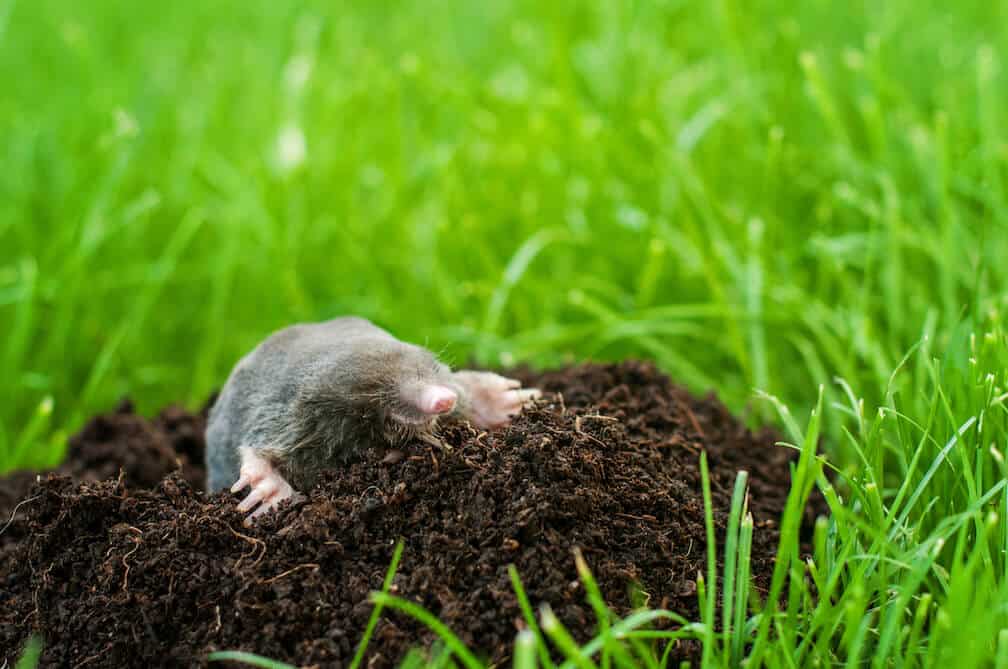These small mammals are found all over the world and are often considered pests in lawns and gardens because of their digging habits. Weighing in at around 4 ounces and measuring around 6 or 7 inches, these little creatures have a hairless snout, tiny eyes, and no visible ears. Their habitat includes grasslands, urban areas, gardens, sand dunes, woodlands, and any other area where there is enough soil to dig tunnels.
Mole tunnels have more than one purpose and sometimes a series of tunnels will remain in use for several generations of moles. These tunnels not only provide the moles with routes to get from one area to another, they also provide living spaces. At the end of many tunnels are hollowed out areas that serve as chambers for various purposes. There are chambers for bedrooms, chambers for birthing, and chambers for storing food.
DAMAGES MOLES CAUSE
Moles damage lawns and landscapes. If you are seeing round, symmetrical, volcano-like mounds, this is damage caused by moles. Other sure signs include the mess left behind by the animal's surface tunneling. These raised lines can look like zig zags, veins, or any other pattern. They may also tunnel along the edges of concrete walkways or other manmade borders.
Moles damage trees and ornamentals. Moles can chew on trees causing an eyesore and putting the tree in danger of dying. They also damage plants by tunneling in their root systems.
Moles can bite and are capable of carrying the rabies virus, which is transmitted to humans by a bite. If you come into contact with a wild animal that is not afraid of you, be aware that it might have rabies, and be cautious.
Moles carry parasites. If you are suddenly plagued with fleas, ticks, mites, lice, or other parasites, be aware that wild animals often bring these into yards where pets can pick them up. A mole could potentially bring these parasites close to your home and other animals could bring them inside your home, animals such as mice, rats, or squirrels.
MOLE PREVENTION TIPS
Before giving a few prevention tips that will help to keep moles away from your property, let us first mention a few things that have been tried, that don't work to keep moles away, Mothballs and flooding do not work. It only makes the moles dig more tunnels to get away. Pouring gasoline into mole holes is ineffective and potentially dangerous. And "poisons" bought from a bait company are generally ineffective. Instead of these ineffective strategies, try the following.
-
Install underground fences: These can be costly and time-consuming but, if you are just trying to protect a small area, such as a garden, then they may be helpful in keeping moles out. Keep in mind that the fence must be at least 24 inches under the ground and 6 inches above the ground. Galvanized fencing works best because it is resistant to rusting.
-
Make a gravel pit: Dig a pit around the area you want to keep moles out of and fill it with gravel. Gravel is too hard for mole claws to dig through. Make sure the gravel is at least one foot deep.
-
Reduce food sources: To reduce moles' primary food sources, worms and insects, make your yard less attractive to these things by drying it out as much as possible and using a roller. Worms and insects prefer wet, loose soil. This may, however, work against your efforts to have a beautiful green lawn. Worms and insects help to aerate the soil.
-
Allow pets to roam in your yard: Moles are afraid of dogs and cats and will be less likely to stick around if they are present.
-
Contact a professional pest control company.
If you are tired of dealing with moles destroying your yard, your flowers, your trees, and getting into your garden, it is time to reach out to a professional pest control company. Here at Rottler Pest Solutions, we have been helping people get rid of moles, and a whole host of other pests, since 1956. We have the experience and technology to help.


